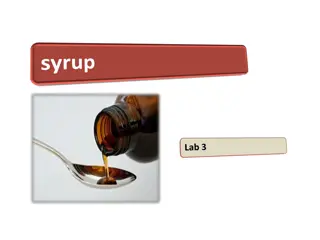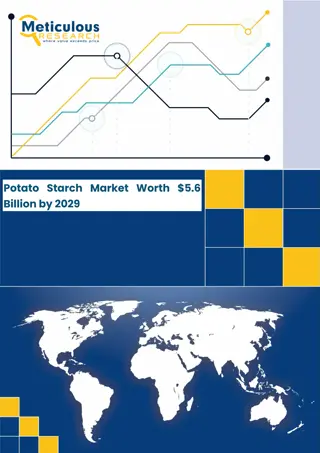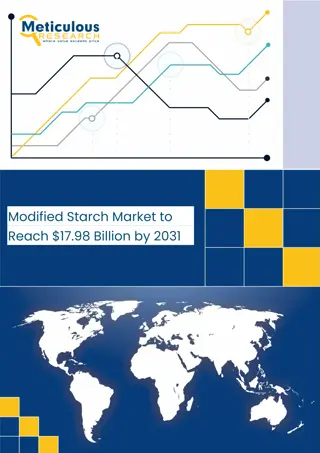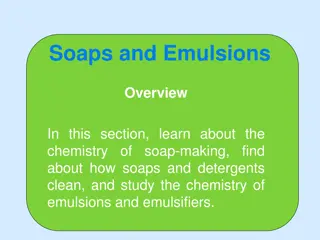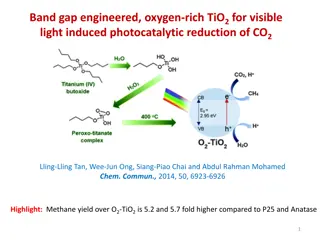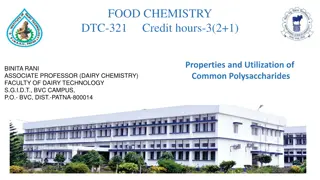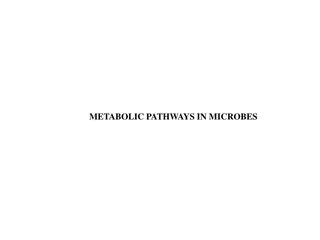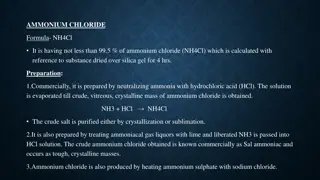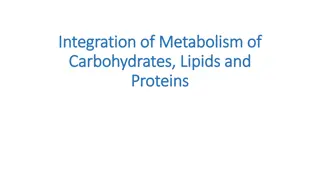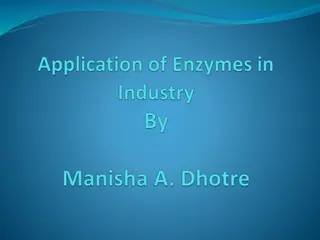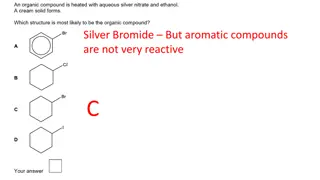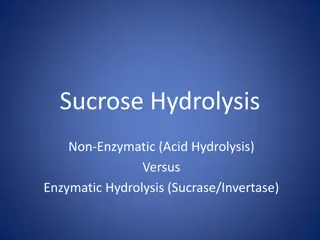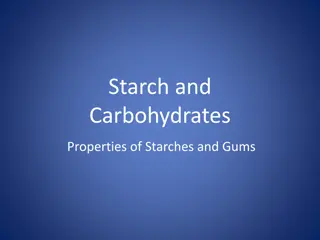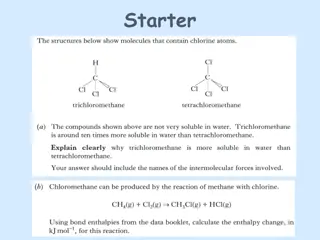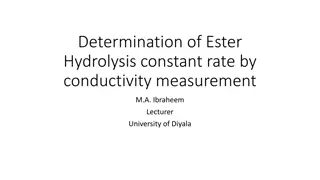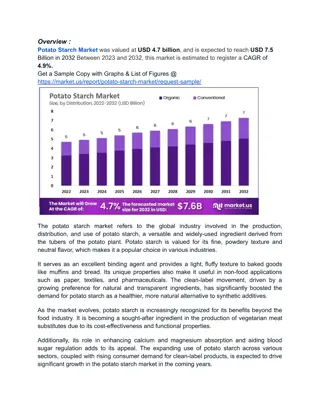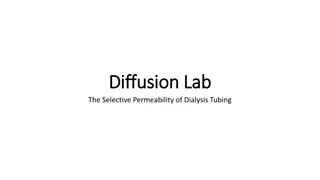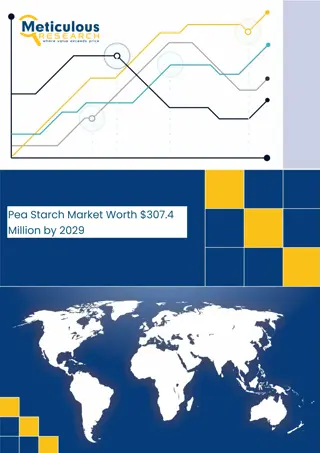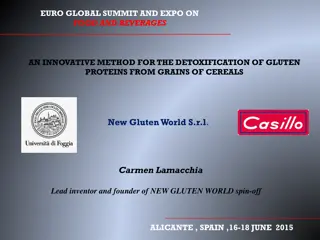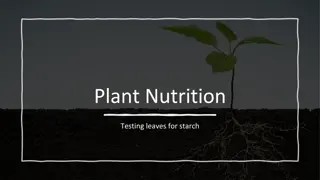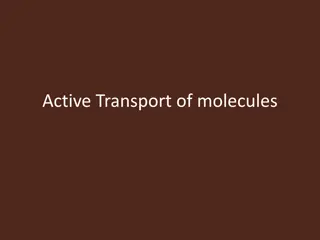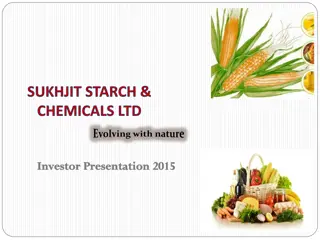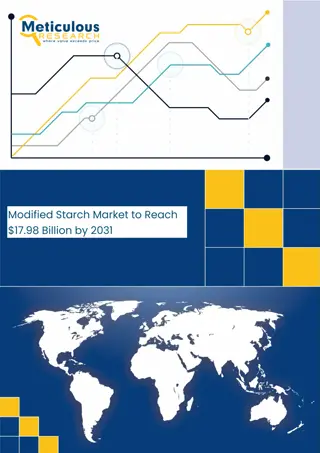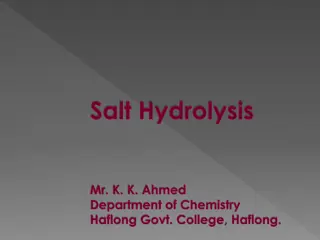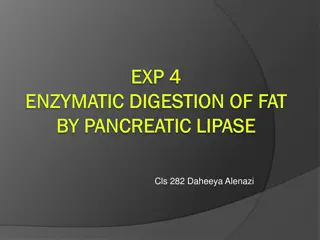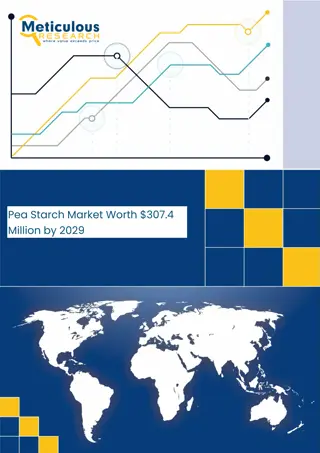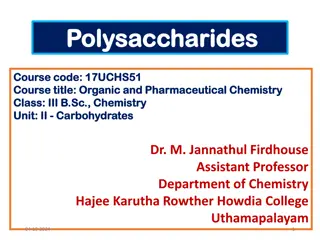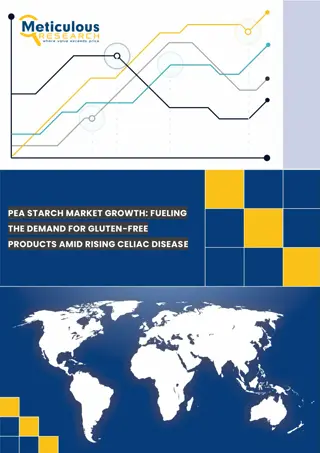Understanding Motor Proteins and Cytoskeletal Dynamics in Cell Biology
Motor proteins, such as myosin, kinesin, and dynein, utilize chemical energy to move along cellular tracks, influencing processes like muscle contraction, organelle movements, and cellular migration. With the ability to translocate using ATP hydrolysis, these proteins play crucial roles in various c
5 views • 14 slides
Understanding Syrups: Types, Formulations, and Storage Considerations
Syrups are sweet, viscous liquids used in pharmaceutical preparations. They can be non-medicated for flavoring or medicated for therapeutic purposes. There are sugar-based and sugar-free syrups, with sucrose preferred for its purity and handling ease. Preservatives like benzoate and sorbic acid are
4 views • 16 slides
Potato Starch Market Worth $5.6 Billion by 2029
The potato starch market is projected to reach $5.6 billion by 2029, at a CAGR of 3.9% from 2022 to 2029.\n
1 views • 4 slides
Modified Starch Market to Reach $17.98 Billion by 2031
Explore $17.98 billion Modified Starch Market: Get exclusive insights on key market trends, segments, geographical analysis, & competitive analysis!\n
1 views • 5 slides
Understanding Digestion and Absorption in the Gastrointestinal Tract
Digestion and absorption in the gastrointestinal tract are crucial processes for breaking down carbohydrates, fats, and proteins into smaller compounds that can be absorbed by the body. Carbohydrates undergo hydrolysis to convert into monosaccharides, fats are broken down from triglycerides, and pro
1 views • 22 slides
The Chemistry of Soaps and Emulsions: An Overview
Explore the fascinating world of soap-making and emulsions' chemistry. Discover how soaps are formed through alkaline hydrolysis, the structure of soap molecules, and how they clean oily stains effectively. Learn about emulsions, emulsifiers, and the science behind soap production.
1 views • 24 slides
Band Gap Engineered Oxygen-Rich TiO2 for Visible Light-Induced Photocatalytic Reduction of CO2
Band gap engineering and oxygen-rich modifications in TiO2 have been explored for visible light-induced photocatalytic reduction of CO2. The engineered O2-TiO2 photocatalyst exhibited significantly higher methane yield compared to conventional TiO2 types. The preparation involves hydrolysis of titan
1 views • 17 slides
Properties and Utilization of Common Polysaccharides in Food Chemistry
Polysaccharides are carbohydrates with more than 10 monosaccharide units, commonly found in foods like starch, cellulose, glycogen, hemicellulose, and pectic substances. Starch, a natural polymer of D-glucose, is a major energy source in the human diet, present in cereals, roots, and tubers. It cons
0 views • 22 slides
Investigating Amylase Activity in Starch Digestion
An investigation on amylase activity involving the digestion of starch was conducted, with methods for controlling temperature, calculating digestion rates, and improving data precision discussed. The effects of temperature on enzymatic activity and precision enhancement techniques were explored.
0 views • 47 slides
Understanding Metabolic Pathways in Microbes
Metabolism in living organisms involves anabolism and catabolism, where anabolism generates essential biomolecules for growth using energy, while catabolism breaks down nutrients for energy release. Anabolic processes include synthesis of carbohydrates, lipids, proteins, nucleic acids, and other gro
7 views • 24 slides
Overview of Ammonium Chloride: Properties, Preparation, and Uses
Ammonium Chloride, with the formula NH4Cl, is a compound containing not less than 99.5% NH4Cl. It is prepared commercially by neutralizing ammonia with hydrochloric acid or treating ammoniacal gas liquors with lime. The compound is essential for maintaining acid-base equilibrium, acts as an expector
2 views • 4 slides
Understanding the Integration of Carbohydrate, Lipid, and Protein Metabolism
The integration of metabolism involving carbohydrates, lipids, and proteins can be divided into three stages: hydrolysis to simpler units, preparatory stage, and oxidative stage. In the hydrolysis stage, complex polysaccharides, lipids, and proteins are broken down to simpler forms. The preparatory
3 views • 13 slides
Demonstration of Salivary Amylase Enzyme Action in B.Sc. Practical
Salivary amylase, an enzyme found in saliva, partially hydrolyzes starch into maltose. This practical involves observing the action of salivary amylase on starch, demonstrating how starch is broken down into glucose and maltose. The procedure includes preparing solutions, collecting saliva, mixing w
0 views • 5 slides
Enzymes in Industrial Processes: Applications and Benefits" (58 characters)
Enzymes play a crucial role in various industrial processes, such as denim bleaching, food production, brewing, and more. They are used for enhancing efficiency, achieving desirable outcomes, and creating innovative products in industries like food, dairy, starch, brewing, and paper. Enzymes like am
0 views • 16 slides
Synthesis of Salicylic Acid: Theory, Derivatives, and Applications
Salicylic acid is synthesized from methyl salicylate through ester hydrolysis with aqueous alkali. It is a versatile compound used in organic synthesis, as a plant hormone, and derived from salicin metabolism. The derivatives of salicylic acid can minimize gastric disturbances and enhance therapeuti
4 views • 12 slides
Organic Chemistry Concepts and Reactions
Learn about reactions involving silver bromide, nucleophilic substitution to prepare ethers, steam and acid catalyst reactions, reaction mechanisms using curly arrows, allyl bromide reaction with sodium hydroxide, alcohol synthesis, alkaline hydrolysis, and bromine water identification. Understand m
0 views • 12 slides
Understanding Sucrose Hydrolysis and Reducing Sugars in Carbohydrate Chemistry
This content delves into the mechanisms of sucrose hydrolysis through non-enzymatic and enzymatic processes, highlighting disaccharides like sucrose, lactose, and maltose. It explores the significance of glycosidic bonds in carbohydrate structures and discusses the reducing capacity of sugars such a
7 views • 16 slides
Understanding Starch and Carbohydrates in Food Science
Explore the properties of starch and gums, the characteristics of starches like amylose and amylopectin, important processes such as gelatinization and retrodegradation, factors affecting starch gelatinization, and a lab experiment to investigate the factors impacting the thickness of cooked starch
0 views • 14 slides
Understanding Proteins: Functions, Structure, and Breakdown
Explore the world of proteins, from their essential functions in living organisms to the chemistry of amino acids that form them. Learn how proteins are structured, the significance of amide links, and how they are broken down through hydrolysis. Delve into the importance of essential amino acids an
0 views • 17 slides
Determination of Ester Hydrolysis Constant Rate by Conductivity Measurement
This study focuses on determining the ester hydrolysis constant rate through conductivity measurement, presenting a second-order reaction example. Conductivity meter is utilized for accurate monitoring. The procedure involves utilizing equal concentrations of ester and sodium hydroxide, measuring co
0 views • 6 slides
Understanding the Hydrolytic Activity of Salivary Amylase on Starch
Enzymes play a crucial role in catalyzing chemical reactions in the human body. This experiment focuses on the hydrolytic activity of salivary amylase on starch, breaking down polysaccharides into intermediate products like maltose. The mechanism of amylase action, types of amylase, and the assay me
0 views • 16 slides
Potato Starch Industry Navigates Volatile Prices and Supply Chain Issues
Potato Starch Market By Type (Native Starch, Modified Starch, and Sweeteners Grade), By Nature, By End User, By Region and Companies - Industry Segment Outlook, Market Assessment, Competition Scenario, Trends, and Forecast 2023-2032
0 views • 4 slides
Colorimetric Detection of Hydrogen Peroxide Using Magnetic Rod-Based Metal-Organic Framework Composites
Nanomaterials, particularly magnetic rod-based metal-organic frameworks composites, are gaining attention for their exceptional properties and various applications in different fields. This study by Benjamin Edem Meteku focuses on using these composites for colorimetric detection of hydrogen peroxid
0 views • 16 slides
Exploring Dialysis Tubing Permeability: Glucose, Starch, and Iodine Experiment
This experiment investigates the permeability of dialysis tubing to glucose, starch, and iodine. By observing color changes and conducting tests, the study demonstrates the selective movement of molecules across the membrane, highlighting the concept of selective permeability in cells.
0 views • 9 slides
Demonstration of Salivary Enzyme Amylase Action in B.Sc. Practical
Salivary enzyme amylase, also known as ptyalin, plays a crucial role in breaking down starch and glycogen into maltose. This practical session in the Zoology department explores the action of salivary enzyme amylase at a temperature of 37°C and pH of 6.6. By conducting experiments with starch, iodi
0 views • 8 slides
Pea Starch
Explore $307.4 million Pea Starch |: Get exclusive insights on key trends, segments, geographical analysis, & competitive analysis!
1 views • 4 slides
Innovative Detoxification Method for Gluten Proteins in Cereals at Euro Global Summit on Food and Beverages
Presentation at the Euro Global Summit and Expo on Food and Beverages highlighted an innovative method for the detoxification of gluten proteins from grains of cereals by New Gluten World S.r.l. The event discussed scientific context, technology, and research progress related to the detoxification p
0 views • 33 slides
Understanding Starch Adhesives in the Corrugation Industry
This material discusses the importance of starch adhesives in the corrugation industry, covering topics such as classifications, testing parameters, and manufacturing methods. It also delves into the necessity of adhesives, different types of starch adhesives available, and the application of variou
0 views • 12 slides
Understanding Plant Nutrition: Testing Leaves for Starch
Learn about testing leaves for starch in plants, the importance of starch as a storage molecule, and the procedure for conducting an iodine test to detect starch levels. Explore the steps involved, the rationale behind each step, and the significance of destarching plants before experimentation.
0 views • 13 slides
Understanding Active Transport of Molecules: Driven by ATP Hydrolysis
Active transport, fueled by ATP hydrolysis, facilitates the movement of molecules against their concentration gradients, essential for processes like ion pumping across membranes. The Na+-K+ pump, a prime example, utilizes ATP to transport Na+ and K+ ions across cellular membranes, maintaining impor
0 views • 23 slides
Evolution of Sukhjit Starch & Chemicals Ltd - Investor Presentation 2015
Sukhjit Starch & Chemicals Ltd, a leading producer in India, highlights its business overview, product overview, management vision, industry dynamics, financial highlights, and strategic outlook in the investor presentation. With a history of consistent growth and strong management, the company has
0 views • 25 slides
Modified Starch
Explore $17.98 billion Modified Starch : Get exclusive insights on key trends, segments, geographical analysis, & competitive analysis!
1 views • 3 slides
Understanding Salt Hydrolysis in Chemistry
Salt hydrolysis is a chemical process in which a salt reacts with water to produce an acid and a base. This reaction occurs when the cation or anion of the salt interacts with water, resulting in either an acidic or basic solution. The type of hydrolysis depends on the strength of the acid and base
0 views • 6 slides
Understanding Leaf Structure and Photosynthesis in Biology
Green plants use photosynthesis to make their own food by converting light energy into starch and oxygen through chlorophyll in the chloroplasts of their cells. Learn about the structure of a leaf and how to test for starch in this informative presentation.
0 views • 6 slides
Enzymatic Digestion of Fat by Pancreatic Lipase
The experiment focuses on studying the enzymatic digestion of fat by pancreatic lipase. It covers the structure of triglycerides, the role of lipase enzyme in hydrolyzing triglycerides to release fatty acids, and the general hydrolysis process. The aim is to investigate the effects of lipase enzyme
0 views • 9 slides
Pea Starch
Explore $307.4 million Pea Starch Get exclusive insights on key trends, segments, geographical analysis, & competitive analysis!
1 views • 4 slides
Understanding Polysaccharides: Structure and Function in Chemistry
Polysaccharides are complex carbohydrates made up of multiple monosaccharide units linked by glycosidic linkages. Examples include starch, cellulose, and glycogen. Starch, a major plant carbohydrate, consists of amylose and amylopectin. Amylose forms a linear structure, while amylopectin is highly b
0 views • 13 slides
Pea Starch
Explore $307.4 million Pea Starch Get exclusive insights on key trends, segments, geographical analysis, & competitive analysis!
1 views • 4 slides
Modified starch (2)
Explore $17.98 billion Modified Starch Get exclusive insights on key trends, segments, geographical analysis, & competitive analysis!
1 views • 3 slides

